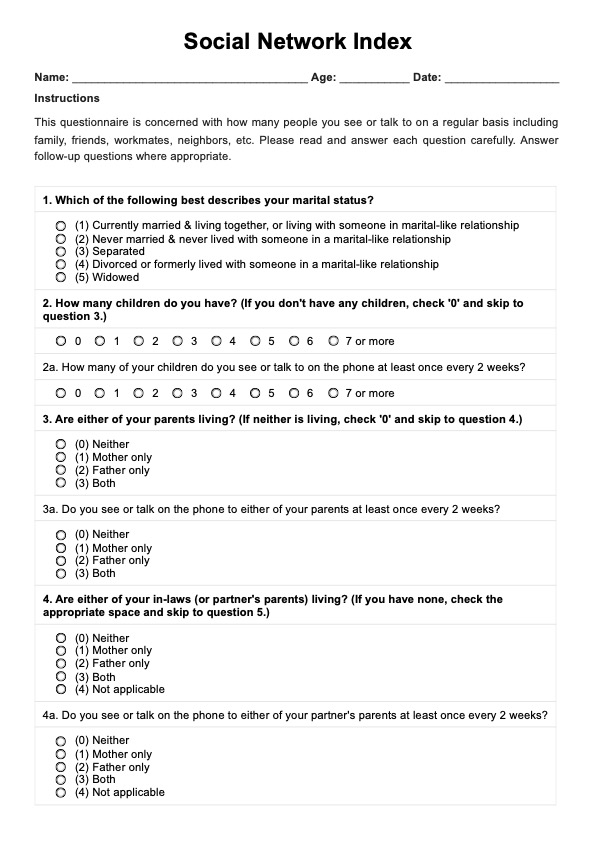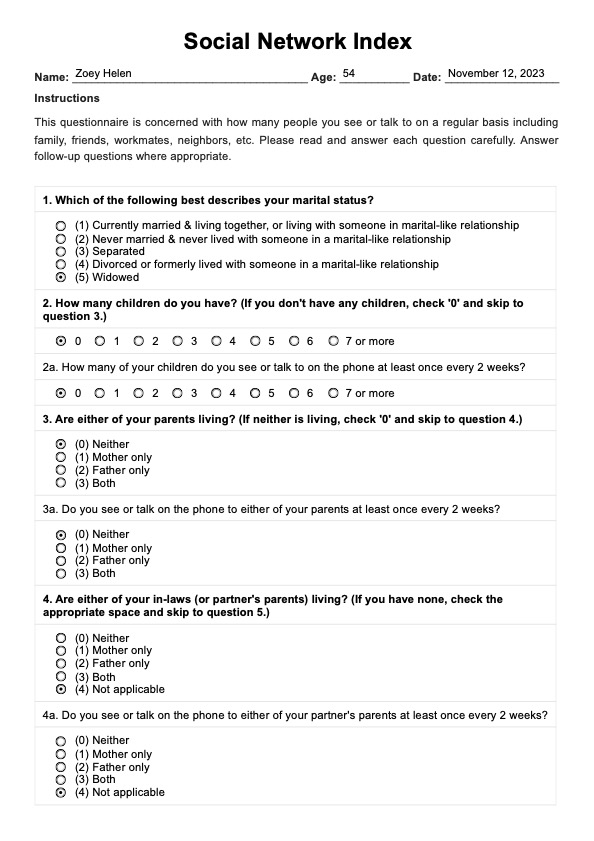Social Network Index
Discover how to assess your patient's social connectedness with the Social Network Index. Get a free PDF template here.


What is the Social Network Index?
The Social Network Index (SNI) is a self-reported questionnaire designed to assess the type, size, closeness, and frequency of interactions within an individual’s social network. It classifies individuals according to their level of social connectedness, enabling researchers to identify those at risk of social isolation.
Cohel et al. (1997) introduced the SNI in their study, Social Ties and Susceptibility to the Common Cold, to examine whether sociability can predict resistance to infectious diseases and if this relationship is influenced by the quality and quantity of social interactions and relationships.
The index consists of 12 questions with various sub-questions. It aims to assess an individual’s social network diversity, including their number of close ties, frequency of interactions, and the type of support they receive from others.
The index measures the following components:
- Number of high-contact roles (Network diversity): This refers to the number of social roles in which the respondent engages regularly, defined as having contact with at least one person at least once every two weeks.
- Number of people in social network: This figure represents the total number of individuals with whom the respondent maintains regular contact, defined as at least once every two weeks.
- Number of embedded networks: This metric is designed to capture the variety of network domains in which a respondent is engaged.
Social Network Index Template
Social Network Index Example
How to use our Social Network Index template
Carepatron has created an easy-to-use Social Network Index template to make it easy for you to capture your patients' level of social connectedness. Here's how to use it:
Step 1: Download the template
Use the link on this page to download the Social Network Index. You can choose to download the PDF copy or use our in-app version via the Carapatron app.
Step 2: Give your patient a copy
Provide a copy of the form to your patient and explain to them how to fill it out. Ask your patient to complete the Social Network Index, answering all questions honestly. Remind them that there are no right or wrong answers, and their responses will remain confidential.
Step 4: Interpret the results
Once your patient has completed Cohen's Social Network Index, score it using the scoring interpretation provided in the template. This will help you determine their social connectedness level and identify areas where they may need more support.
Step 5: Discuss the results with your patient
Schedule a follow-up appointment to discuss the results with your patient. Use this opportunity to explore ways to strengthen their social connections and address any areas of concern highlighted by the index.
Social Network Index scoring
As mentioned, the Social Network Index scores the respondents' number of high-contact roles or network diversity, the number of people in social networks, and the number of embedded networks. Below are how these components are scored:
Number of high-contact roles (Network diversity)
To assess network diversity, assign a score of 0 for each of the 12 potential high-contact roles if the respondent does not hold that role and a score of 1 if they do. The overall number of high-contact roles is determined by summing the scores for the following items: 1, 2a, 3a, 4a, 5a, 6a, 7a, 8a, 9a & 9b, 10, 11a, and 12.
Number of people in social network
To determine your patient's social network score, count the individuals with whom the respondent maintains regular contact. The overall social network size is calculated by summing the contacts across the 12 identified roles presented in these Social Network Index items: 1, 2a, 3a, 4a, 5a, 6a, 7a, 8a, 9a & 9b, 10, 11a, and 12.
Number of embedded networks
To accurately assess the embedded network number, your patient must meet specific criteria across various domains. For each domain, the individual must have at least four high-contact individuals to receive a point. In the case of family roles, the five family roles are combined into a single network, requiring at least three high-contact family roles and four high-contact individuals to earn a score.
If the respondent meets the established criteria for any embedded network, assign a score of 1 for that network. If the criteria are not met, assign a score of 0. The total embedded networks score is calculated by summing the scores of 0s and 1s across the evaluated networks presented in these items: 1, 2a, 3a, 4a, 5a, 6a, 7a, 8a, 9a & 9b, 10, 11a and 12.
Download our free template to get the full picture of how the Social Network Index scoring works.
Next steps after the assessment
After assessing your patient's social network and embedded networks, it is essential to analyze the implications of these findings on their mental health. Understanding the dynamics of social relationships can provide valuable insight into the emotional support they receive from group members.
Consider the number of embedded networks, as these reflect the structure and strength of social integration in the patient’s life. Factors such as marital status may influence the quality of social relationships, so it's crucial to explore how these dynamics may lead to social isolation or enhanced emotional support.
Regular follow-ups and engaging patients in discussions about their social relationships can further aid in assessing social networks and improving mental health outcomes. By maintaining a focus on fostering connections among group members, you can facilitate better emotional well-being and resilience in your patients.
Reference
Cohen, S., Doyle, W. J., Skoner, D. P., Rabin, B. S., & Gwaltney, J. M. (1997). Social ties and susceptibility to the common cold. The Journal of the American Medical Association, 277, 1940-1944. https://pubmed.ncbi.nlm.nih.gov/9200634/
Commonly asked questions
Social network definition may vary from person to person. For some, it may include only close friends and family, while others may also encompass acquaintances, colleagues, and online connections. Therefore, it is essential to have a comprehensive understanding of an individual's social networks to accurately assess their support system and overall well-being.
The Social Network Index (SNI) is a quantitative measure designed to evaluate the diversity and strength of an individual's social relationships within their network. By utilizing the SNI, healthcare professionals can gain insight into the support systems surrounding their patients, which is pivotal in understanding their overall mental health and well-being. Recognizing how a group member contributes to an individual's social fabric can facilitate targeted interventions to foster healthier connections and improve mental health outcomes.
The size of a social network can be measured in various ways, including the number of people an individual regularly interacts with, the frequency and quality of interactions, and the diversity of relationships within the network. Other factors, such as geographic proximity and access to resources, can also play a role in determining the size of one's social network.
Assessing an individual's social networks is crucial because social support has been linked to various positive health outcomes, including better emotional well-being and resilience. Understanding the dynamics of an individual's social connections can provide valuable information for healthcare professionals in developing personalized treatment plans and interventions to improve overall mental health.





















-template.jpg)


















































































